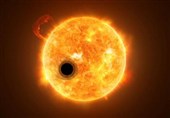Astronomers Confirm Discovery of Moon-Forming Disk around Young Exoplanet
TEHRAN (Tasnim) – Two years ago, astronomers spotted an apparent circumplanetary disk around a planet outside of our solar system, but they couldn’t be certain.
Follow-up observations now show they were right, in a discovery that could improve our understanding of exomoons and how they form in emerging star systems.
Protoplanet PDS70c has a circumplanetary disk, according to new research published in The Astrophysical Journal Letters. Scientists thought as much in research published two years ago, but they weren’t able to distinguish the disk from its surrounding environment, leading to doubt. Follow-up observations made by the Atacama Large Millimetre/submillimeter Array (ALMA) in Chile were key to the confirmation.
“Our ALMA observations were obtained at such exquisite resolution that we could clearly identify that the disc is associated with the planet and we are able to constrain its size for the first time,” explained astronomer Myriam Benisty in a statement. Benisty, who led the study, is a researcher at the University of Grenoble, France, and at the University of Chile.
By observing the system in submillimeter light (a wavelength parked between the microwave and infrared part of the spectrum), the team was able to confirm the presence of copious amounts of dust in orbit around PDS70c. The disk, if were located in our solar system, would extend from the center of the Sun to a distance slightly beyond Earth’s orbit.
This Jupiter-like protoplanet, along with its equally gigantic sibling, PDS70b, is in orbit around a young, 5-million-year-old star located 370 light-years from Earth. The star itself hosts a circumstellar disk, within which the two protoplanets are sucking up material, resulting in pockets, or cavities, around them. Both PDS70b and PDS70c are gas giants, and both are far from their host star, at distances of 22 AU and 34 AU, respectively. By comparison, Neptune is 30 AU from our Sun, with 1 AU being the average distance of Earth to the Sun.
The circumplanetary disk around PDS70c is roughly 500 times larger than Saturn’s rings, and, as the new paper points out, the amount of mass in this disk could form up to three exomoons the size of our own Moon.
Interestingly, the new research rules out a circumplanetary disk around PDS70b. The scientists say its greedy sibling, PDS70c, is not a good sharer, and that it gobbled up the requisite building material for itself.
“This system,” according to Stefano Facchini, a co-author of the paper and a research fellow at the European Southern Observatory, “offers us a unique opportunity to observe and study the processes of planet and satellite formation.”
Indeed, the confirmation of a circumplanetary disk around PDS70c could add new clarity to ongoing theories about exomoons and how they form. In one possible scenario, protoplanets steal mass from the surrounding circumstellar disk, and the resulting blobs of mass fall onto the forming planet. But some bits of matter stay in orbit, clumping together to form natural satellites.
It’s an exciting finding, but the team is not done with the PDS70 system quite yet. They’re already looking forward to the ESO’s Extremely Large Telescope, which is currently being built in Chile’s Atacama desert. Using this tool, the astronomers are hoping to acquire even higher resolution scans of the system and build three-dimensional views showing gas moving through the circumplanetary disk.






